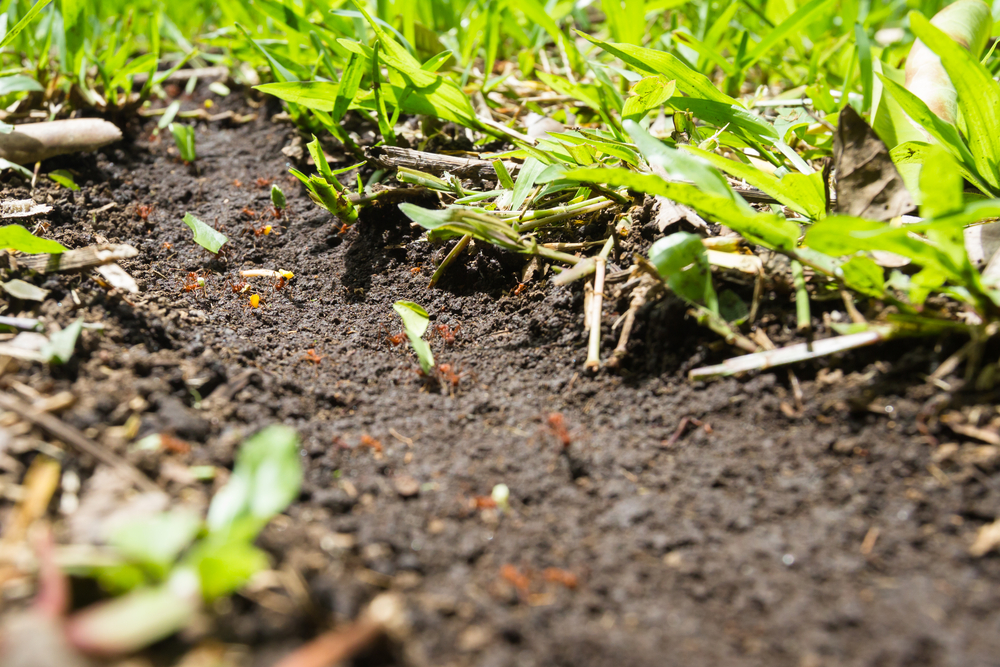
How to Identify and Remove Ants from Your Yard
November 6, 2017
How to Create a Beautiful Lawn
January 9, 2018Depending on the aftermath of winter, caring for your lawn during the spring can be easy or rather challenging. No matter the outcome, it must be done to ensure your lawn stays beautiful and flourishing. Here are some ways to take care of your lawn once spring rolls around that will help your yard maintain its beauty all year long.
- Remove thatch. Thatch, a name for dead or decaying grass roots, can be good for your lawn if there is less than ½ inch present. Too much of it, however, can suffocate the yard. It’s best to rake all forms away to prevent the appearance of pests and disease. Removing thatch can be abrasive to your lawn’s surface, so you’ll want to start removal at the beginning of a growth period so your lawn can recover. For thick amounts of thatch (more than 1-inch thick), use a power rake. For anything less, use a standard yard rake.
- Check the pH level of your soil. Healthy lawns have a pH level between five and seven. If the level is too high, incorporate sulfate with a broadcast spreader. If the level is too low, add lime in the same manner. Make sure you read instructions so you don’t overdo or fail to do enough when it comes to additives. Once you’ve added either sulfate or lime, water your lawn and test again in 30 days.
- Let it breathe. When soil has been compacted, nutrients aren’t properly absorbed and roots have very little room to grow. Loosen the soil to prevent this from happening by using aerator shoes or a gas powered aeration tool.
- Kill the weed, add the feed. Late spring is the best time to get rid of weeds and add fertilizer to your lawn. Don’t add weed killer unless weed is a serious issue on your lawn. Too many chemicals upon your lawn can negatively affect the plant roots and put them at risk during the hotter season of summer. Spot spray or pull weeds instead, and apply slow-release fertilizer.
- Cover the bald spots. These barren spots on your lawn can be treated with water, removal of dead grass, and leveling with sand and soil before reseeding and watering.
- Activate your green thumb. Early spring is the best time to plant seeds; however, be mindful of colder soil conditions, which can slow the growth process. If you don’t need to plant during spring, fall is the second best time of year to do so.
- Know your grass and what’s best for your lawn. Depending on the climate in which you live and how much sunlight comes into your yard, you may have to do some research to find which type of grass works best for your lawn.
- Maintain a healthy water supply. The amount of water your lawn needs depends upon the type of grass that has been planted. If you cannot afford an irrigation system, a sprinkler with a timer will work just fine.
- Mow when necessary. Make sure your blades are always sharp, as grass can heal quickly after being cut. Don’t cut more than the top third of the blade off. Anything more could cause the plant to brown. Cool season grass is best when at a height of two-four inches tall and warm season grass, which is shorter, requires more frequent lawn cutting sessions. Don’t stick to the same pattern of mowing; going in different directions is beneficial to your lawn, as it ensures a uniform cut, an upright growth pattern, and it reduces the risk of soil compaction.
- Keep your lawn clippings. If you mow utilizing the 1/3 rule, your lawn clippings will act as mulch, as they are rich in compounds and can feed the lawn. Don’t mow if the grass is wet or else the clippings will form clumps.


